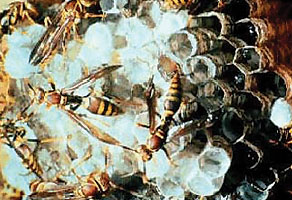Paper Wasps
If growing vegetables and flowers is your hobby, you may consider paper wasps as welcomed guests. Like many other social wasps, paper wasps feed on many insect pests of gardens. Unfortunately, paper wasps will also feed on fruits, damaging their appearance and will scrape wood from houses to make their nests. Though they are not aggressive, paper wasps can sting, making them a concern to many people when these wasps build their nests in or around homes.
Appearance: There are many different types of paper wasps with different habits and life cycles. The most common paper wasps are about 5/8 to 3/4 inch in length. Many are brownish with yellow markings, though a few species have reddish markings.
Habits: During the winter, most paper wasps die, except new queens. Queens survive the winter by nesting in protected places such as under the bark of trees, or in cracks and crevices around structures. In the spring, several queens commonly get together to start a new nest. Eventually, one queen will dominate the others, making them serve as workers for the new colony.

Paper wasps often build umbrella-shaped nests around homes
By scraping and chewing wood into a pasty pulp, paper wasps make paper-like nests in the shape of an umbrella. These nests are built in protected locations including in shrubs, on tree branches, on porch ceilings, window and door frames, roof overhangs, attic rafters, and under decks, joists or railings. The queen deposits eggs in the comb (cells) on the underside of the nest. After the eggs hatch, the grub-like immatures are mostly fed other insects, such as caterpillars, that the worker wasps collect. Once the larvae have matured, they pupate in their cells and join the colony as an adult. Adult paper wasps mainly feed on nectar.
Though paper wasps do not readily attack people, they will sting if they feel threatened or provoked. Many times people are stung when they bumble into paper wasp nests hidden in bushes or around homes.
Control: Since most paper wasps die by the first hard frost, workers found late in the year may not require treatment. Most nests in natural areas away from structures should be left alone to allow the wasps to feed on garden pests. If several wasps are seen flying in one area around your home, inspect the area for the protected places these wasps like to build nests. Remember that some nests may be hidden from views such as in an attic, under a deck rail or porch floor. If the nest is found, spray it directly with an aerosol insecticide labeled for wasp and hornet control. There are many products available at home centers and retail stores. Use a product that can spray up to 20 feet and provides quick knock-down and kill of the wasps. Treat in the early evening hours when all the wasps are on the nest. Do not use a flashlight to illuminate the nest as the wasps could be attracted to the light. Do not stand directly under the nest when you are treating. Wear protective clothing including a long sleeved, collared shirt, long pants, shoes, socks and a hat at a minimum.
Remove the nest after the wasps are killed to discourage future paper wasp nests. If new paper wasp colonies continue nesting in the same areas around your home, consider making alterations. For example, if wasps are nesting in attic areas or other voids, exclude them by screening any openings or vents. On exterior surfaces, a fresh coat of paint or varnish will make it difficult for the wasps to attach their nests to the slick surface. Finally, keep bushes well trimmed and properly thinned to discourage paper wasps from nesting on inner branches.
Prepared by Eric P. Benson, Extension Entomologist/Associate Professor and Patricia A. Zungoli, Extension Entomologist/ Professor, Department of Entomology, Soils, and Plant Sciences, Clemson University.
Providing Leadership in Environmental Entomology
Department of Entomology, Soils, and Plant Sciences, 114 Long Hall, Clemson, SC, 29634-0315, 864-656-3111
This information is supplied with the understanding that no discrimination is intended and no endorsement by the Clemson University Cooperative Extension Service is implied. Brand names of pesticides are given as a convenience and are neither an endorsement nor guarantee of the product nor a suggestion that similar products are not effective. Use pesticides only according to the directions on the label. Follow all directions, precautions and restrictions that are listed. EIIS/MV-13 (New 12/2002).
